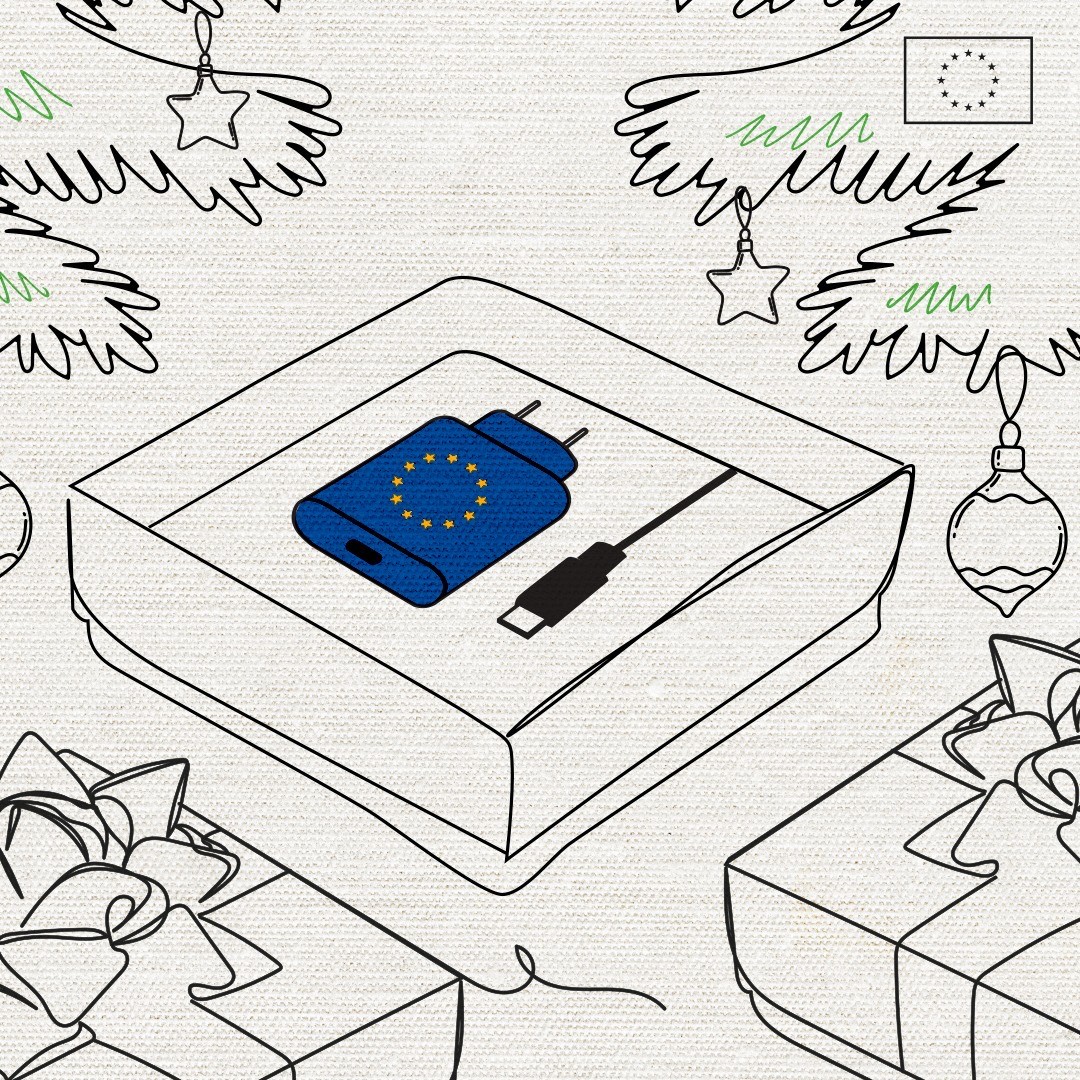cross-posted from: https://jlai.lu/post/3226934
The wait is finally over. From 2024, USB-C will be the common standard for electronic devices in the EU – and we have already seen the impact !
It means
- 🔌The same charger for all phones, tablets and cameras
- ⚡ Harmonised fast-charging technology
- 🔄Reduced e-waste
One charger to rule them all.
Now, a reality.
Learn more about the #EUCommonCharger here: https://europa.eu/!hwjj3G
Unbundling the sale of a charger from the sale of the electronic device .
The ‘common charging’ requirements will apply to all handheld mobile phones, tablets, digital cameras, headphones, headsets, portable speakers, handheld videogame consoles, e-readers, earbuds, keyboards, mice, and portable navigation systems as of 2024. These requirements will also apply to laptops as of 2026. Such transition periods will give industry sufficient time to adapt before the entry into application.
Consumers will be able to purchase a new electronic device without a new charger. This will limit the number of chargers on the market or left unused. Reducing production and disposal of new chargers is estimated to reduce the amount of electronic waste by 980 tonnes yearly
Producers will need to provide relevant visual and written information about charging characteristics, including information on the power the device requires and whether it supports fast charging. This will help consumers understand if their existing chargers meet their new device’s requirements and/or help them select a compatible charger. Combined with the other measures, this will help consumers to limit the number of new chargers purchased and save at least €250 million a year on unnecessary charger purchases.
L’attente est finalement terminée. À partir de 2024, l’USB-C deviendra la norme commune pour les appareils électroniques dans l’UE – et nous avons déjà vu son impact !
Cela signifie
- 🔌Le même chargeur pour tous les téléphones, tablettes et appareils photo
- ⚡ Technologie de charge rapide harmonisée
- 🔄Réduction des déchets électroniques
Un chargeur pour les gouverner tous. Maintenant, une réalité. Pour en savoir plus sur le #EUCommonCharger, cliquez ici : https://europa.eu/!hwjj3G
Les exigences de « charge commune » s’appliqueront à tous les téléphones mobiles portables, tablettes, appareils photo numériques, écouteurs, casques, haut-parleurs portables, consoles de jeux vidéo portables, liseuses électroniques, écouteurs, claviers, souris et systèmes de navigation portables à partir de 2024. Ces exigences s’appliquera également aux ordinateurs portables à partir de 2026. De telles périodes de transition donneront à l’industrie suffisamment de temps pour s’adapter avant l’entrée en application.
Les consommateurs pourront acheter un nouvel appareil électronique sans nouveau chargeur. Cela limitera le nombre de chargeurs sur le marché ou inutilisés. On estime que la réduction de la production et de l’élimination des nouveaux chargeurs permettrait de réduire la quantité de déchets électroniques de 980 tonnes par an.
Les producteurs devront fournir des informations visuelles et écrites pertinentes sur les caractéristiques de charge, y compris des informations sur la puissance requise par l’appareil et s’il prend en charge une charge rapide. Cela aidera les consommateurs à comprendre si leurs chargeurs existants répondent aux exigences de leur nouvel appareil et/ou les aidera à sélectionner un chargeur compatible. Combinée aux autres mesures, cette mesure aidera les consommateurs à limiter le nombre de nouveaux chargeurs achetés et à économiser au moins 250 millions d’euros par an sur les achats inutiles de chargeurs
I just wish there was a standard for marking the cables, so you could look at the cable and tell what it was capable of. All the cables and chargers look the same but have wildly different capabilities. 
and the naming scheme doesn’t make it any better, “USB 3.2 Gen 3 with USB PD and/or CuickCharge” just doesn’t make sense to rationally thinking people.
how about “USB C-C up to X amount of mbytes and 100W charging”?
And WiFi is going the opposite direction. From 802.1a/b/ax/whatever to WiFi 5, 6 etc.
(Although the MIMO chains can get a bit more complex, but still fairly simple compared to the USB bs)this is the way.
The last one is what’s happening now, or was that a fever dream I had
Letting parts of the USB-C spec be optional was a mistake. The USB Implementers Forum has completely lost the plot on what a “standard” is supposed to accomplish!
These are the same folks that released “USB 3.2 Gen 2x2” as an actual name for a specification (which if I’m remembering my USB specs correctly is the current branding for the original USB 3 spec)and muddied the waters so badly that most companiesnand reviewers just state the speed of the port rather than the version
As well as the “U” in USB, interpreted rather generally
We need something like resistor band labeling for chargers. Yellow for 1A, Green for 2A and another band for the charging standard such as PD QC3.0 and so on.
As it stands now we are going to need a station in stops to test cables.
It’s because the USB-IF is fucking terrible at their jobs and can’t figure out how to name things in a meaningful way.
Yeah i discovered that and i was extremely furious. I bought a usbc cable around 10€ and it wasn’t working because the device only supported a certain type of usbc. Apparently, there is some info about information in the eu website.
But i’m not able to understand any technical part…i just want a color : yellow charger/cable go with yellow port. Etc.
i’m not able to understand any technical part
I’ll break it down for you - it’s a long list but easy to understand:
- Some cables have four internal wires. Others have over a dozen wires.
- Some have thin wires, some have thick wires. The thick ones cost more and are less flexible - the main benefit is they can be longer while charging quickly.
- Some cables have the internal wires wrapped in plastic. Others have them wrapped in plastic then that’s wrapped in a metal shield, then that’s wrapped in another plastic layer. The latter is more reliable and not just for the cable itself (without shielding, the cable can interfere with other electronics that are near the cable - such as your computer or phone.
- Some are just ordinary cabling, and some have complex circuitry embedded in the cable to run advanced algorithms to remove noise from the cable - this is necessary to achieve high data rates at long cable lengths.
- Nearly all use copper cables. A few use fibre optic cables. This can handle even longer cable lengths
- Some cables are just like “whatever this will do”, and others are well designed and carefully manufactured/tested/etc.
.
i just want a color : yellow charger/cable go with yellow port. Etc.
There would need to be something like a fifty colors. The USB standards body is pushing cable manufacturers to use labels that show data rates (gigabits per second) and power capabilities (watts) on every cable. That will help a lot, but for all the other stuff (especially shielding and general quality…) you need to rely on either brand reputation or third party tests. Even then you need to be careful, because the best brands don’t put all those features in every cable (too expensive).
Also unfortunately at 10€ you get what you pay for. The better brands all charge more than that.
And thank a lot for this great recap, i’m saving it. ☺️
Well i didn’t expect ton of features. I just wanted a simple cable to transfer data. According to the cablenotice, it should. But fiio sold a device with an usbc proprietary cable that can only transfert data in one direction. And no usbc-usbc can connect to it, i have to buy a fiio’s cable as apple’s lightening.
Then i dig and discovered this whole usb-c mess. It breaks intoperability. That’s why i was mad. It’s inefficient and wasteful…and no vendors were able to help me when i sked which cable can work with it.
They don’t know cable as you do, and i guess i have to take lesson on cable myself as i can’t trust manufacturer nor its vendors that are as knowledgeable as me. I should have gone to the hacker fab lab first.
“Simple cable to transfer data” is hiding a lot of detail. USB 2 speeds? USB 3 (and which version of USB 3?) speeds? Transfer video data? Is it Thunderbolt data?
It sucks. The standards committee really dropped the ball and now just shrugs their shoulders and throws more shit on the pile.
For myself, any power-only cable is literally cut in two and thrown out upon discovery. And the data stuff is handled by intuition: thin cables are assumed to be slow, heavier/higher quality cables are assumed to be faster, and the thunderbolt cables are kept separate. Fortunately the only TB cables I have are actually marked as such on the connector moulding, but that apparently isn’t a requirement.
Yeah you are right…
Well i admit, first, i didn’t care about speed. But maybe for high quality, and smooth transfert, i should have chose the hightest.
Hopefully i didn’t because the fiio device only accept unidirectional usb-c. It don’t accept bidirectionnal cable. There was an arrow. I thought biderectionnal cable should do the job…😅
Even worse, many of the features require a ID chip in the cable, so a simple continuity test can’t determine what the cable actually supports.
I have stuck labels on all my DP capable cables - it is very annoying not to get video output, and “does this cable even work for video” being one of the things you need to debug.
Yeah, something like [usb icon]⚡📺
USB-C is a connection standard, nothing else. The USB technology in the cabling isn’t what’s being made a standard. It’s like how Cat 5 internet cabling looks identical to Cat 6 internet cabling, but the performance is different.
It doesn’t help the average user, I’ll agree though.
Absolutely. I think it should have labels instead of colors tho. Because vendors can use different colors for same standards, which they’re doing right now.
For example random unique two-lettered labels printed on the one end of the cable. So we can Google “USB XX” and see what it is capable of and what not. Also vendors can simply say “this product is needed to be used with at least XX USB standard”.
The problem with colors is; there is no one metric for difference. For example two cables can have same data transfer speed while one can have PD and the other one don’t.
I really like this. Being able to just buy bunch of newest generation Type-C and using it everywhere is awesome.
The best part is that you can help your friends. :3
That’s what I was hoping but here in the US it’s still difficult to find charging blocks with multiple USB-C ports, and they’re targeted to high end devices, and we still have too many devices with older and nonstandard connectors. I know it’s not our standard but was certainly hoping theEU could create some sanity for all of us
it’s still difficult to find charging blocks with multiple USB-C ports
They exist but you won’t find them on the shelf of overly cheap chargers at the grocery store or gas station. Seems most of them cost around $50 or more if they’re worth using. Personally I’ve had good luck with Anker (which I just saw in a target electronics section yesterday!), and I’ve heard good things about uGreen on Amazon.
I currently use a 65 watt gAn charger with 3 ports when I work from home to keep my work laptop topped off plus my phone and one other bonus USB C device. My work laptop complains about the low power charger if I have anything else plugged in but is otherwise fine, and it keeps everything nicely charged at a very rapid pace
Angler has done great products for sure, but how about a cheap 3 port: so far I have my phone, watch and Kindle on usb-c, and only the phone can use any significant power. The three together can use at most , say 30w, and I’d be happy with much less since I just need it fast enough to charge overnight
deleted by creator
Some Chinese manufacturers are already working on undermining this by releasing 12V non-PD devices that use the plug. Those devices are not compatible with regular chargers and if you use their power supply for something else that device will be destroyed (because it’s designed for 5V not 12).
The sale of those things will not be legal in the EU so no need to worry.
To be fair, that is true of a lot of dropship stuff on Amazon and EBay already. Claiming EC marking and the like they just don’t meet. The EU needs to come down hard on these market platforms. It’s unfair on legitimate manufacturers and bad/unsafe for consumers.
One of those devices is currently shipping to me via AliExpress… passed import without any issues.
You would think you would know, when you buy from AliExpress, which states specifically that it is shipping from OUTSIDE EU and is IMPORTING DIRECTLY.
It can’t really be any others fault but your own.
Its like saying “You said drugs are illegal but i just got them from my dealer without issue.”
You can buy all sorts of stuff that violates IP laws from ali express too…
Cool, we’ll have a proper laugh at you when you try to get a refund when it burns your house down
Well, it’s not 2024 just yet. And besides that, I don’t think it’s possible to completely control everything that gets imported, but I reckon it’s going to be a rather rare occurrence in the future.
I reckon it’s going to be a rather rare occurrence in the future.
Tech illiterate folks who lack the sense to get concerned by how cheap stuff on AliExpress is (or more accurately, Temu in my MIL’s case) will get burned by this for sure
i mean, you likely already could get some out-of-spec chinese chargers… that’s Always been a risk when goong for low quality stuff!
Can you share a good source here, i will enjoy reading it :)
This is a good video about it: https://www.youtube.com/watch?v=ByxMSOXVyrc
Thank a lot :)
In the US we are seeing a lot of cheap products that are supposedly USB-C. Like the flashlight I got for Christmas. But they will only charge with a USB-A to USB-C cable. They are basically USB-A chargers with a different shaped plug. They will not charge with a real USB-C cable. Is this also true in the EU?
Currently this also seems true in the UK. The cheap USB-C devices I have refuse to charge using a real USB cable. And instead need a USB-A to USB-C cable.
Yeah that’s when they cheap out on a resistor to make it USB/USB-C compliant (since without that they simply don’t request any power. There isn’t any power provided if nothing is requested).
Idk if the rule applies to that.
I’m do not understand why it would not be able to charge with a X to USB-C.
As far as I’m aware, even if one of the two connected devices (such as charger and flashlight) doesn’t have a proper chip for agreeing on voltage, it will just default to 5v. The only thing that should prevent that is a damaged (as in no + or - connection) cable. Even if the data connections are damaged, it should still charge in slow-mode.
Needless to say, I have never experienced that problem even with cheap china cables/chargers, except, of course, for damaged cables.
Edit: There would be one other scenario, being that one cannot charge a device by connecting it to another device which is not capable of charging, such as connecting the flashlight to your computers’ charge-only port.
And yes, I’m from the EU. :)
Edit2: from reading the other comments, I have come to understand that there indeed exist cables which are not capable of properly transferring power, though it boggles my mind as to why.
For c to c cables, the devices need to be able to communicate with each other to establish which one is the host (the charger in this case). With a to c cables, the type a side is assumed to be the host by default. You’ll often find that manufacturers of cheaper devices prefer not to spend the extra money to implement this technology, though some will, and in fact allow for even more functionality. For example, one of my flashlights does have that chip, so it can both charge from a c to c cable if a charger is detected, and also automatically act as a power bank if I connect a device to it such as a mobile phone.
The technology you’re talking about is literally two resistors - parts that cost less than a cent a piece when you get a few hundred.
All I’m hearing is potential savings $$$
Any news on if they are going after Nintendo for it’s non-standard implementation of usb-c?
Yeah I think they’ll definitely get in trouble for that. Nintendo’s official statement that “third party chargers will void your warranty” is pretty clearly a breach of the common charger rule.
And it’s not an empty claim either, some standards compliant third party chargers can actually damage a Nintendo Switch. Nintendo will have to fix that, or else their products might be banned across the EU.
A warranty is supposed to be if it is faulty then they offer to replace it (and depending on the country these stipulation about using 3rd party chargers may not be enforceable, or illegal). Nintendo needs to prove you damaged the hardware under abnormal conditions, not using a spec charger in perfectly working order.
I know if I connect my phone to the switch charger it flips out too. So that’s gotta get resolved too
I wish smartwatches were included too so that I could travel with just one charger and one cable. I guess waterproofing a USB-C port is not that easy though (for the ratings those watches usually have).
Yeah. Wireless charging helps some of that, especially if the pad is itself connected through a USB-C cable.
Ideally, in my mind, someday phones themselves will be able to charge wireless devices, so we’ll connect the phone through the USB-C cable and place the watch on top and they’ll both be ready to go in the morning.
Some phones can already do that, like wireless powershare (Samsung)
Yeah mine does, I love it. I just want it to be standard.
it’s definitely looking like it will be standard. the new iPhones do it too.
Google phones had and maybe still have it. There was an ad about it of one of their phones charging an iPhone.
My phone has reverse wireless charging.
It’s slow and terrible, but does work
What about wireless charging with a USB C wireless charging pad?
I can relate to this. I’ve got a Garmin and I’m traveling currently. The best solution I could find was to get a Garmin - USB-C adapter with a little loop at the end, so I tied it to my existing USB-C cable and can plug in the adapter whenever I need to charge my watch.
What about little pucks as a compromise?
Or ideally, a single standsrdised one
Is it only the physical connector or also the Power Delivery protocol? Because if it’s only the connector you might end up plugging 2 things that are not compatible with each other.
The law requires a the industry agree to a “common” charger. Right now, the industry has picked USB but that might change.
It’s up to the industry to figure out technical details…
But basically it needs to be possible to buy one charger, from any brand, that will “work” to charge any device. That doesn’t necessarily mean it will work well… a 5w charger might take 20 hours to charge a full size laptop battery for example… And that’s if the laptop is off. Some USB chargers provide 240w… you probably don’t want one of those for regular use though - they will be big and heavy and expensive. And a small battery won’t charge that fast anyway.
Sorry i’m very bad at understanding how power work but maybe the link and the documentation can answer your question ?
I read the website but it doesn’t say. But it does say that the consumer will have to check that the charger is compatible with the device so you might end up frying your device if you connect them to the wrong USB C Charger (things that were prevented because of the different connectors). I don’t say that the directive is wrong but it doesn’t go far enough. It should force all devices manufacturers and chargers manufacturers to use the power delivery protocol so consumers don’t have to worry about power compatibility between chargers and devices.
The power delivery protocol allows for the device and the charger to negotiate a charging power.
Without delivery protocol the charger delivers as much power as it’s can so it might fry the connected device.
No device that is properly following the USB standard will be fried by, or fry, another USB device.
It’s true that a USB-C cable might not work with some PD requirements and will support only a certain USB data version or lower, but all of USB is backwards compatible, you will get slower speeds or less power but not anything dangerous.
Unless the device(s) you use are not properly following the USB standards.
That might be what some document says, but it’s definitely NOT true in the real world. Benson Leung (no longer doing reviews but still active on reddit) proved that by meticulously testing chargers from many manufacturers (some of the popular ones too).
Many chargers even amongst the popular brands could fry your device if the device isn’t being careful. I’m not sure it gotten better in the last 5 years.
As others mentioned in the thread, Nintendo Switches clearly don’t follow the standards. So having this hole patched in the legislation would be nice.
Oh…something it telling me it won’t end well. I was full of hope after all those bad new on politic and climate change. I really hope they anticipated it. 😔
I can’t wait for this to be a thing - we may not have any such requirements in the US but should get some advantage.
I’m just frustrated that it doesn’t seem to be happening yet. Back in September I got a new iPhone with USB-C and wanted to jump directly to USB-C everywhere, but it’s pretty rare outside of phones. I know the older full sized USB is capable for small devices, as is mini usb and micro usb, but it’s really frustrating to have to buy so many cables when we could have had a standard
USB C just means I now have to have USB cables with 6 different connectors instead of 5.
I had a similar issue so I went ahead and bought converters. Now I have at least a buffer of one cable I can convert to either USB A or micro B.
Does it specify C-to-C? Or can cables be A-to-C?
The c port is specifically for mobile devices iirc. You will still see A ports on computers and laptops, but phones, tablets, and probably some wearables will be USB-C port only
Devices (not just laptops) can still have any port - it’s just that at least one of them has to be the “common” charger port (as far as I know, USB-C isn’t part of the legislation. It has provisions for the industry to adopt something different in the future).
Yes, I was glad reading the EU commission proposals seeing it allows for newer emerging standards.
The main talking point of people on Reddit/Lemmy who rallied against this law were people saying it would make us stuck on USB C forever. Clearly that was nonsense.
The way God intended
Let’s get the next debate going and standardise on either a 2 pin euro or 3 pin UK socket now 😂
I’m afraid its worst than you think 😂

And another thing. In fact 3 pins is a security measure. 2 pins is for low powered device. I forgot if it was to prevent power outage or something else.
The third pin is for grounding devices. Devices that aren’t guaranteed by design to stop the user accessing live voltage need a ground wire.
In the UK all devices need the ground pin on the plug. Even if a ground isn’t required on the device. Sometimes they are plastic. UK plugs use the longer ground pin as a key that opens the ports to the live and neutral wires. This makes it difficult for children to insert metal things into the live port.
Very cool, thank for the lesson 😁👍
So we should adopt UK plug as long it’s not the driver’s rule.
They are as an inverted pic of french civilisation. For example their food 😋 (i’m joking)
Excellent idea! If only they weren’t so disgustingly bulky 😂
The have more features than the average plug.
They were initially designed to be installed by the user (initially devices were sold without plugs). So you could unscrew and rewire them easily.
They also have fuses inside them that are user replaceable. This allowed the UK to use wiring systems in the wall that use less cooper - saving money. It also makes the devices safer. Each device has its own fuse adding redundancy and allowing for smaller fuses for lower powered devices.
The size is the price we pay for safety and repairability.
Obligatory Tom Scott video about UK Plugs
Cool and we see the fuse inside the plug ☺️
I like the brown one. Why aren’t we all switch to that lil smiling face? :)
The schuko plug is widely adopted over here in Italy too. Usually for computers and appliances with high current requirements (ovens, refrigerators)
The first one has two grounds It’s the one in use where I live I find it pretty good
Why would EU even consider the Brexit standard?
Realistically they never would, and wouldn’t have even when the UK was in the EU due to the wider prevalence of other socket types.
But if you want an answer as to why they should, it’s because it’s an excellent socket design; just about as safe as it’s possible to make a mains electricity connection, and practically indestructible to boot.
The EU plug is designed so that the pins for power become unreachable before they reach the socket and become powered, and ground wire touches the ground pins before that as well.
I’ll be the contrarian here. I like the US plug - the basic two-prong, non-polarized variant.
It doesn’t have any safety features, but it sure is compact. It’s easy to make it fold flat even in tiny USB cubes.
They make em just as compact with the UK plug too 😀

Yer, that won’t be forever. Brexit hasn’t worked out well.
Don’t see what Brexit has to do with this. I’m of the opinion that Brexit was stupid, but it’s getting tiresome that Brexit gets brought up whenever the UK is mentioned, even when completely unrelated.
The Type-G (UK) plug is a genuinely remarkable design. Really, everywhere should have adopted it.
Of course, switching all plugs and sockets is ludicrously tedious and costly, so it’s not happening. Especially since most plugs are “good enough” already.
So what is the standard fast charging solution they’ve choosen?
The site doesn’t say.
Are we going to see USB-PD in more phones now?
I’d love to see all the different manufacturers standards bugger off.
Ive seen USB C accessories work in one socket and not in another and it pisses me off way too much. If anyone can decide on what is the protocol the connector is hardly universal. Making sure a particular charger will be 100% compatible with your accessories involves long research into confusing acronyms and then it doesn’t work when you buy it.
There is a section of useful links on the page. 9 links in total. One of them is a factsheet on proposed common charger.
I am a huge fan of USB-C and have been waiting for it to come to the US for years. I hope that it will be here soon and that more companies will adopt it.
I’m really curious to see the knock on effects of this legislation down the road. There’s bound to be issues at some point where the USBC law stifles something somewhere, and there’s bound to be someone that finds a way around it somehow.
I like the uniformity to reduce ewaste in particular, but wish rules like this could be more nimble.
Yes. The Commission tried to get manufacturers to adopt this voluntarily for years. They almost all did. Almost. Basically, this needs to be binding legislation just for Apple.
I don’t think this will impede innovation or getting better speeds. Just as we have done with USB-A, we will just implement new generations with faster speeds in the same form factor and they will have backwards compatibility.
The EU law defers to USB IF and allows them to update the standard, so if there’s newer better ports for mobile devices released then it can basically be rubberstamped, plus protocol updates for USB C devices are not impeded at all.
The only plausible near-term issue would be if somebody else created a more compact and robust port with equivalent capabilities (and that will likely take some time) which they want to put as the only port in some devices covered by the regulation.
I’m mostly curious about the laptops part because many laptops with discrete GPUs and high power components often come with 125 watt or more charging bricks, which is pushing the limits of USB Power Delivery without more specific cables and chargers. If someone launches a laptop (well more like a portable workstation) that needs 200-300 watts how’re they going to power that over USB C, and what kinds of malicious compliance are we going to see for these edgecases?
USB PD can currently do up to 240W. From what I understand, there’s still more headroom, so if/when devices need more power they can continue to extend the standard.
I’m hoping the legislation doesn’t forbid dual charging ports, where the device has usb charging which works as well as it can, and then a proper charging port. My current laptop has that configuration.
Because there’s also the issue of durability. A barrel power connector can freely rotate which can absorb a lot of stress when the laptop is moved around. I think a usb-c cable that’s used the same way would fail a lot sooner, especially with all the delicate wiring it has in comparison.
My Dell 7560 mobile workstation is powered by USB C when connected to the docking station, which is rated at 230 watt as I recall.
🔌Le même chargeur
In terms of water proofing, how well does the usb-C port hold up? Water damage is one of the main causes of death for mobile phones. I wanted to see better water proofing overall and wonder if this would be a setback in that regard.
Don’t get me wrong, I’m very thrilled to have USB c as the standard.
I know waterproof Type C ports exist as electrical components. So the test is up to the manufacturer to correctly implement it.
Ultimately, Type C is no worse an option to other ports.
I have Honor Magic 5 Pro, and it is rated IP68. Dudes even submerged it on the launch event. I only had it in use once while it was raining and it’s okay for now.
I mean, I would hope literally any phone on the market could survive rain.




















